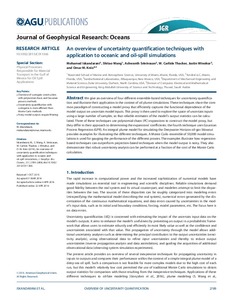| dc.contributor.author | Iskandarani, M. | |
| dc.contributor.author | Wang, S. | |
| dc.contributor.author | Srinivasan, A. | |
| dc.contributor.author | Carlisle Thacker, W. | |
| dc.contributor.author | Winokur, J. | |
| dc.contributor.author | Knio, O. M. | |
| dc.date.accessioned | 2020-02-13T21:26:00Z | |
| dc.date.available | 2020-02-13T21:26:00Z | |
| dc.date.issued | 2016 | |
| dc.identifier.citation | Iskandarani, M.; Wang, S.; Srinivasan, A.; Carlisle Thacker, W. ; Winokur, J. and Knio, O.M. (2016) An overview of
uncertainty quantification techniques with application to oceanic and oil-spill simulations, J. Geophyshysical Research: Oceans, 121, pp.2789–2808 DOI:10.1002/2015JC011366. | en_US |
| dc.identifier.uri | http://hdl.handle.net/11329/1214 | |
| dc.identifier.uri | http://dx.doi.org/10.25607/OBP-731 | |
| dc.description.abstract | We give an overview of four different ensemble-based techniques for uncertainty quantification
and illustrate their application in the context of oil plume simulations. These techniques share the common
paradigm of constructing a model proxy that efficiently captures the functional dependence of the
model output on uncertain model inputs. This proxy is then used to explore the space of uncertain inputs
using a large number of samples, so that reliable estimates of the model’s output statistics can be calculated.
Three of these techniques use polynomial chaos (PC) expansions to construct the model proxy, but
they differ in their approach to determining the expansions’ coefficients; the fourth technique uses Gaussian
Process Regression (GPR). An integral plume model for simulating the Deepwater Horizon oil-gas blowout
provides examples for illustrating the different techniques. A Monte Carlo ensemble of 50,000 model simulations
is used for gauging the performance of the different proxies. The examples illustrate how regression based
techniques can outperform projection-based techniques when the model output is noisy. They also
demonstrate that robust uncertainty analysis can be performed at a fraction of the cost of the Monte Carlo
calculation. | en_US |
| dc.language.iso | en | en_US |
| dc.rights | Attribution 4.0 International | * |
| dc.rights.uri | http://creativecommons.org/licenses/by/4.0/ | * |
| dc.subject.other | Uncertainty quantification | en_US |
| dc.subject.other | Polynomial chaos | en_US |
| dc.subject.other | Gaussian processes | en_US |
| dc.subject.other | Integral plume model | en_US |
| dc.title | An overview of uncertainty quantification techniques with application to oceanic and oil-spill simulations. | en_US |
| dc.type | Journal Contribution | en_US |
| dc.description.refereed | Refereed | en_US |
| dc.format.pagerange | pp.2789-2808 | en_US |
| dc.identifier.doi | 10.1002/ 2015JC011366 | |
| dc.subject.parameterDiscipline | Parameter Discipline::Physical oceanography | en_US |
| dc.bibliographicCitation.title | Journal of Geophysical Research: Oceans | en_US |
| dc.bibliographicCitation.volume | 121 | en_US |
| dc.description.sdg | 14.A | en_US |
| dc.description.bptype | Manual (incl. handbook, guide, cookbook etc) | en_US |
| obps.contact.contactname | M. Iskandarani | |
| obps.contact.contactemail | miskandarani@rsmas.miami.edu | |
| obps.resourceurl.publisher | https://agupubs.onlinelibrary.wiley.com/doi/full/10.1002/2015JC011366 | en_US |
 Repository of community practices in Ocean Research, Applications and Data/Information Management
Repository of community practices in Ocean Research, Applications and Data/Information Management

